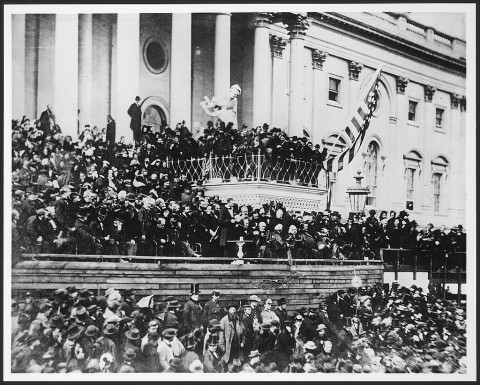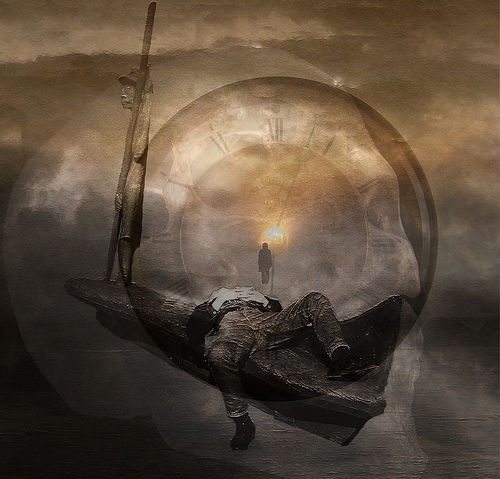A while back I was sent a book, “Moving Mountains: Or the Art and Craft of Letting Others See Things Your Way,” by Henry M. Boettinger. It was from an old and trusted friend. I’d never heard of the book – but was in dire need of a door stop – so I flipped it over before taking advantage of my good fortune. I caught a glimpse of a familiar name, Drucker. That made me stop.The book had a rare testimonial from the legendary Peter Drucker.
“I’m greatly impressed with Henry Boettinger’s book. I think that it goes way beyond its title and is a first-class, highly original and highly practical, treatise both on how one thinks and how one presents thinking. I would consider it the first truly modern searching essay on rhetoric – in the classical meaning of the term – in the last three or four hundred years.” – Peter Drucker
MOVING MOUNTAINS
I read it. And it was. The book is all about ideas-manship. The planning, packaging and presenting of ideas. Great ideas can die on the boulevard of broken dreams without great presentations. Good presentations meld creation and performance into a symphonic unity. Great presentations – like Shakespeare’s play Julius Caesar – do that and one other crucial thing. Do you know what it is?
“I have heard and watched practitioners in most areas of modern life in their attempts to persuade – lawyers, natural and social scientists, soldiers, civil servants, executives, physicians, engineers, foremen, politicians, mechanics, labor union leaders, shop stewards, artists, musicians, architects, philosophers, film makers, advertising men, accountants, college students, clubwomen, men of the cloth, sundry teachers, and lesser breeds without the law, to name a few. Some were eminent, most unknown. All were persons of intelligence, having something worthwhile to say, but the range of persuasive skill ran from embarrassing, painful failures (including cases of physical collapse) to skillful performers whose presentations were perfectly tuned to their audiences, and who made changing your mind an exhilarating experience. What makes the difference? Neither schooling, material, nor rank of this I’m sure. Whether the audience was one or a thousand, success invariably attended only those who both understood and presented their ideas from the viewpoint of the needs and characteristics of the persons in their audience.” – Henry M. Boettinger
Think back to events, presentations, stories, and speeches. What really determined their success or failure for you? The best? The worst?
I LOVE TO GIVE PRESENTATIONS — DON’T YOU?
I can only think of three things, off the top of my head, I’d rather do than give a presentation. Be boiled in oil, drawn and quartered or buried alive – or all three at one time. But I do appreciate the genius it takes to pull off a great presentation.
PRESENTATION CHECKLIST TOOL
If you could read only one book on how to give an effective presentation (for any occasion) – read this one. At the end of this article, are two checklists from the book that will help you give the best presentation possible and evaluate presentations of others. You need to read the book to fully understand all of it, but it’s a great resource document to forever change the way you think of business presentations … and the way you deliver them. Because …
EVERY PRESENTATION IS A STORY
Below are some stellar presentations. They’re also exceptional ideas, stories and dreams. They run the gamut of industries and topics. Some are about business. Some life. Some are funny, some sad. Tragic even. Some new, some old. Some are speeches, some no spoken words, just images. Some use PowerPoint, some PowerPoint-less. But all have one thing in common. One crucial thing. Can you tell what it is?
DID YOU KNOW?
The first, “Shift Happens: Effects of Globalization.”
Created by Karl Fisch, and modified by Scott McLeod; Globalization and The Information Age.
THE MOUNTAINTOP
Doctor Martin Luther King Jr.
WHEN IT COMES TO TECH, SIMPLICITY SELLS
(Humorous, but absolutely realistic, classic)
by New York Times technology columnist David Pogue
TRIBUTE TO THE
CHALLENGER ASTRONAUTS
“We will never forget them, nor the last time we saw them, this morning, as they prepared for their journey and waved goodbye and “slipped the surly bonds of earth” to “touch the face of God.”
NO ARMS. NO LEGS. NO WORRIES.
Is this a presentation? Yes. Is it a performance? Yes. One of the finest about the strength of will, love, and the potential of the human spirit.
DON’T GIVE UP.
DON’T EVER GIVE UP.
Jim Valvano, Arthur Ashe Courage Award Acceptance Speech – March 4, 1993
THE FIRST MACINTOSH
iPHONE INTRODUCTION
HOW NOT TO USE POWERPOINT
THE LAST LECTURE
If you had one last lecture, one last thought to give before you die … what would it be?
Dr. Randy Pausch
THE GREATEST PRESENTATION OF ALL-TIME?
My pick for the greatest presentation of all time has no video, no PowerPoint, no audio recording. Just a picture and 697 words. Words that not only changed a nation – but were spoken with an eloquent sophistication borne on the wings of simplicity, emanating from a god-like heart, and that now ring eternally, ethereally, through time and heaven.
Words that always make me wonder, did a man like this really ever walk the earth? Will another like him come? Ever again? Read. Just take the time to read it below. Put yourself back in time. Listen to the words. And when you come to this phrase,
“Both parties deprecated war; but one of them would make war rather than let the nation survive; and the other would accept war rather than let it perish. And the war came.”
Those last four words …
“And the war came.”
Has any more ever been said with less?
41 days later Abraham Lincoln was dead.
LINCOLN’S SECOND INAUGURAL ADDRESS
WASHINGTON D.C. , MARCH 4, 1865
“At this second appearing to take the oath of the presidential office, there is less occasion for an extended address than there was at the first. Then a statement, somewhat in detail, of a course to be pursued, seemed fitting and proper. Now, at the expiration of four years, during which public declarations have been constantly called forth on every point and phase of the great contest which still absorbs the attention, and engrosses the energies of the nation, little that is new could be presented.
The progress of our arms, upon which all else chiefly depends, is as well known to the public as to myself; and it is, I trust, reasonably satisfactory and encouraging to all. With high hope for the future, no prediction in regard to it is ventured. On the occasion corresponding to this four years ago, all thoughts were anxiously directed to an impending civil war. All dreaded it–all sought to avert it. While the inaugural [sic] address was being delivered from this place, devoted altogether to saving the Union without war, insurgent agents were in the city seeking to destroy it without war–seeking to dissole [sic] the Union, and divide effects, by negotiation. Both parties deprecated war; but one of them would make war rather than let the nation survive; and the other would accept war rather than let it perish. And the war came.
One eighth of the whole population were colored slaves, not distributed generally over the Union, but localized in the Southern part of it. These slaves constituted a peculiar and powerful interest. All knew that this interest was, somehow, the cause of the war. To strengthen, perpetuate, and extend this interest was the object for which the insurgents would rend the Union, even by war; while the government claimed no right to do more than to restrict the territorial enlargement of it. Neither party expected for the war, the magnitude, or the duration, which it has already attained.
Neither anticipated that the cause of the conflict might cease with, or even before, the conflict itself should cease. Each looked for an easier triumph, and a result less fundamental and astounding. Both read the same Bible, and pray to the same God; and each invokes His aid against the other. It may seem strange that any men should dare to ask a just God’s assistance in wringing their bread from the sweat of other men’s faces; but let us judge not that we be not judged. The prayers of both could not be answered; that of neither has been answered fully. The Almighty has his own purposes. “Woe unto the world because of offences! for it must needs be that offences come; but woe to that man by whom the offence cometh!” If we shall suppose that American Slavery is one of those offences which, in the providence of God, must needs come, but which, having continued through His appointed time, He now wills to remove, and that He gives to both North and South, this terrible war, as the woe due to those by whom the offence came, shall we discern therein any departure from those divine attributes which the believers in a Living God always ascribe to Him?
Fondly do we hope–fervently do we pray–that this mighty scourge of war may speedily pass away. Yet, if God wills that it continue, until all the wealth piled by the bond-man’s two hundred and fifty years of unrequited toil shall be sunk, and until every drop of blood drawn with the lash, shall be paid by another drawn with the sword, as was said three thousand years ago, so still it must be said “the judgments of the Lord, are true and righteous altogether”
With malice toward none; with charity for all; with firmness in the right, as God gives us to see the right, let us strive on to finish the work we are in; to bind up the nation’s wounds; to care for him who shall have borne the battle, and for his widow, and his orphan–to do all which may achieve and cherish a just and lasting peace, among ourselves, and with all nations.” – Abraham Lincoln
###
HOW TO CREATE A GREAT PRESENTATION … A MOVING MOUNTAINS CHECKLIST
Evaluation Checklist for Presentations of Others
1. Is the opening interesting?
2. Is a problem stated clearly?
3. Are the points developed to give a well-rounded view of all relevant aspects?
4. Is the action or belief desired stated clearly?
5. Does the presentor show that he has a vital and passionate interest in the idea presented?
* Is he dominant, submissive, or does he treat the audience as equals?
6. Is the style appropriate for the content?
* Brevity
* Clarity
* Variety
* Mystery or Suspense
* Recapitulation
7. Does the presentor explain or translate technical material well?
8. Are the visuals well designed and related to each other?
9. How well is cross-examination and discussion handled?
10. Is the layout of the room distracting, or does it inhibit discussion?
11. Are the examples, anecdotes, or humor relevant to points made and matched to the style selected?
12. Does the presentor’s idea appeal to Reason, Emotion, and Common Sense?
13. If a “project” type presentation, does the presentor take note of all relevant factors?
* Personnel
* Intelligence
* Operations
* Supply
* External Relations
14. Is the impression created by the presentor one which inspires the confidence of the audience?
* Are there any embarrassing points?
* Are there any nervous or irritating mannerisms?
* Is there a willingness to listen to the suggestions of the audience?
15. Did you learn anything new, or discover new ways to look at the old?
16. Did you see any new approaches which you can use in your own presentation in the future? ____________________________________________________________________
MOVING MOUNTAINS: HOW TO CREATE A GREAT PRESENTATION CHECKLIST
1. Problem-Statement
* What are the two clashing images?
* What exists?
* What do you want to exist?
* Which of the various forms of statement is best:
o Historical Narrative
o Blowing the Whistle
o Crisis
o Adventure
o Disappointment
o Response to an order
o Opportunity
o Revolution
o Crossroads
o Evolution
o Challenge
o The Great Dream Confession
2. Opening Sentence — Will it excite the interest of the audience?
3. What is the “plan” of development?
* Thesis, Antithesis, Synthesis, etc.
4. Do you have examples or anecdotes?
5. What devices do you have to get and hold attention?
* Is there a balance between Reason, Emotion, and Common Sense?
* Can you use assertion, refutation, doubt, and affirmation?
6. Style
* Have you made it as brief as possible?
o Is it oversimplified?
o Is it overembellished?
o Are there any tortured passages?
o Are there any embarrassing ones?
* Is every point clearly expressed?
* What alternations in mood exist?
* Is there a mixture of the lofty and commonplace?
* Can you use suspense or mystery?
* Do you need a recapitulation?
* If a multiple presentation, is a leader appointed?
7. Is the tone one of equality, dominance, or submissiveness?
* Do you really believe in the idea itself?
8. Is the group small or large?
* If large, do you have some humor to “break the ice”?
9. What prejudices, fears, or constraints can you expect from this audience?
10. Have you checked the room for distractions? Have you neutralized them?
11. Is the room layout one that encourages discussion?
12. Are visual aids appropriate?
* Does each one carry a statement of its significance?
* Are the best graphical methods used for statistics?
o If technical, have they been checked for competence by experts?
* Is their size correct?
* Are they related to one another so that someone could extract your message from the set of visuals alone?
13. Have you identified the weak points?
14. What cross-examination questions would you ask if you were in the audience?
* Do you have an answer for each one?
* If challenged on your competence, can you reply appropriately?
* Have you identified those in your audience who may oppose, and who are neutral?
15. Do you state clearly: (1) What you want the audience to do when you are finished? (2) What you wish them to believe?
* Does every point made lead to your ending statement in some way?
* Does the audience need to make great leaps to get to you conclusion?
16. Does the presentation use any special vocabularies unfamiliar to your audience?
* Have these been translated into terms intelligible to them?
17. Are unfamiliar techniques employed?
* Have these been explained?
* Have you established why these are used instead of more familiar methods?
18. Have you considered alternative methods of presenting technical points?
19. If the presentation is a “project” type, have you touched the five areas common to all programs?
* Personnel
* Intelligence
* Operations
* Supply
* External Relations
20. Have you exposed the ideas involved to the original, inquiring, and skeptical minds among your acquaintances?
###
Flickr Photo # 2- Cahron – Eternity – courtesy of H. Kopp Delaney






Recent Comments
Lessons Learned from Hollywood STORY Guru Robert McKee